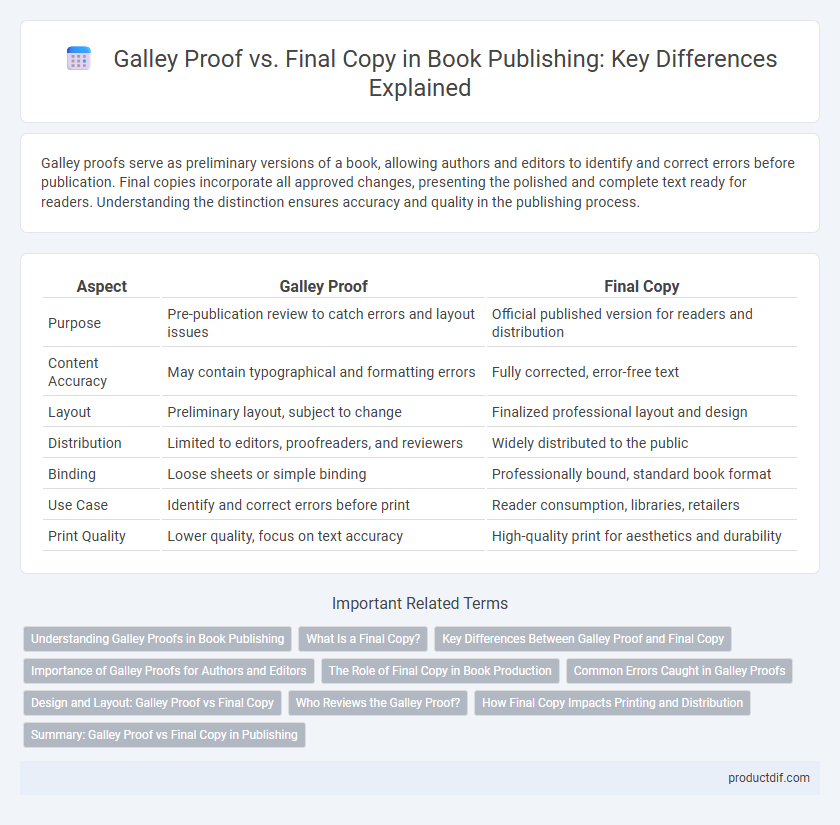Galley proofs serve as preliminary versions of a book, allowing authors and editors to identify and correct errors before publication. Final copies incorporate all approved changes, presenting the polished and complete text ready for readers. Understanding the distinction ensures accuracy and quality in the publishing process.
Table of Comparison
| Aspect | Galley Proof | Final Copy |
|---|---|---|
| Purpose | Pre-publication review to catch errors and layout issues | Official published version for readers and distribution |
| Content Accuracy | May contain typographical and formatting errors | Fully corrected, error-free text |
| Layout | Preliminary layout, subject to change | Finalized professional layout and design |
| Distribution | Limited to editors, proofreaders, and reviewers | Widely distributed to the public |
| Binding | Loose sheets or simple binding | Professionally bound, standard book format |
| Use Case | Identify and correct errors before print | Reader consumption, libraries, retailers |
| Print Quality | Lower quality, focus on text accuracy | High-quality print for aesthetics and durability |
Understanding Galley Proofs in Book Publishing
Galley proofs represent the preliminary version of a book's text, formatted for review before final printing, allowing authors and editors to catch typographical errors, formatting issues, and minor content revisions. These proofs are typically unbound and printed in long strips or digital layouts, facilitating easy markup and correction. Understanding galley proofs is essential in book publishing to ensure accuracy and polish prior to producing the final copy.
What Is a Final Copy?
A final copy is the polished, error-free version of a book, fully formatted and ready for publication or printing. It incorporates all revisions from the galley proof stage, ensuring that spelling, grammar, layout, and design elements meet the highest quality standards. This version is the definitive text that readers will engage with, representing the author's complete and final work.
Key Differences Between Galley Proof and Final Copy
Galley proofs consist of preliminary versions of a book used for review and correction, often lacking final formatting and design elements. Final copies represent the fully edited, typeset, and formatted version ready for publication and distribution. The key differences lie in the presence of editorial marks, layout completion, and the overall polished appearance in the final copy compared to the galley proof.
Importance of Galley Proofs for Authors and Editors
Galley proofs serve as a crucial stage in the publishing process, allowing authors and editors to identify and correct typographical errors, formatting issues, and inconsistencies before the final copy is produced. This pre-publication review minimizes costly mistakes and ensures the book's content aligns with the intended message and quality standards. The accuracy and readability verified during the galley proof phase contribute significantly to the book's professional presentation and overall success.
The Role of Final Copy in Book Production
The final copy in book production serves as the definitive version that incorporates all approved edits and corrections identified during the galley proof stage, ensuring accuracy and consistency throughout the manuscript. It is the finalized text sent to printers or digital publishers, reflecting the author's and editor's final intentions without errors or formatting issues. Proper preparation of the final copy is crucial for maintaining high-quality production standards and delivering a polished, professional book to readers.
Common Errors Caught in Galley Proofs
Galley proofs are essential for identifying common errors such as typographical mistakes, formatting inconsistencies, and missing or incorrect punctuation that often escape earlier editing stages. These proofs allow authors and editors to catch layout issues and ensure text alignment before printing the final copy, preventing costly reprints. Corrections made at this stage improve overall readability and accuracy, making the final copy polished and professional.
Design and Layout: Galley Proof vs Final Copy
Galley proofs showcase preliminary design and layout elements, allowing for adjustments in typography, spacing, and alignment before finalization. The final copy reflects perfected design choices with polished formatting, consistent font usage, and precise image placement to ensure optimal readability and aesthetic appeal. Differences in layout clarity and design refinement distinguish the galley proof stage from the finalized publication-ready version.
Who Reviews the Galley Proof?
Publishers, editors, and authors collaboratively review the galley proof to identify and correct typographical errors, layout issues, and formatting inconsistencies before final publication. Proofreaders play a critical role in examining the galley proof for accuracy and quality, ensuring the text aligns precisely with the author's intent and publishing standards. This stage of review prevents costly mistakes in the final copy, guaranteeing a polished and professional finished book.
How Final Copy Impacts Printing and Distribution
The final copy is crucial in printing and distribution because it ensures all text, images, and layouts are error-free and formatted correctly, preventing costly reprints and delays. Printers rely on the final copy to produce consistent, high-quality books that meet industry standards and specifications. Accurate final copies streamline the distribution process by minimizing issues during binding, shipment, and retail presentation, improving overall efficiency and customer satisfaction.
Summary: Galley Proof vs Final Copy in Publishing
Galley proofs are preliminary versions of a book, designed for final review and correction of typographical errors, layout, and formatting before mass printing. The final copy incorporates all approved revisions from the galley proof, ensuring a polished, error-free publication ready for distribution and sale. This stage guarantees that the text, images, and design elements meet the publisher's quality standards and author's expectations.
Galley Proof vs Final Copy Infographic

 productdif.com
productdif.com